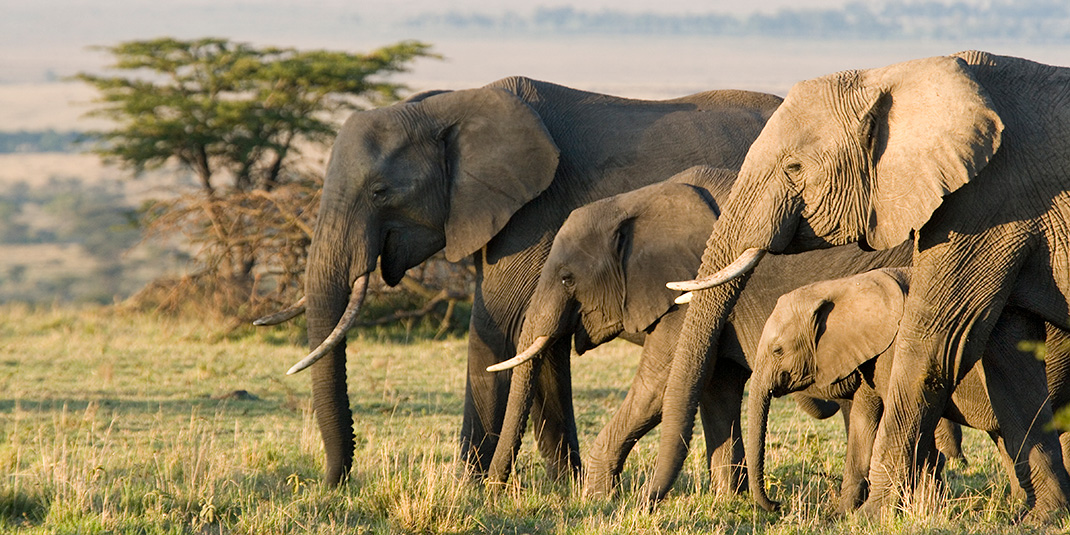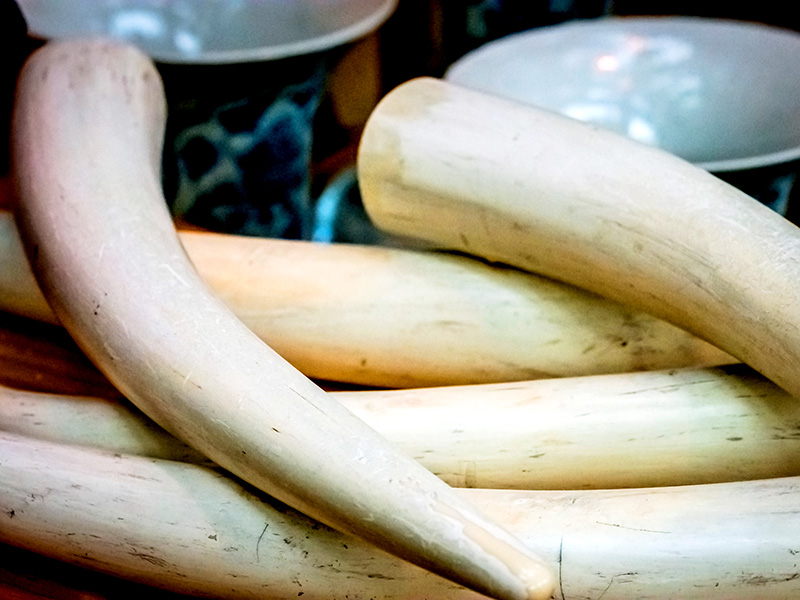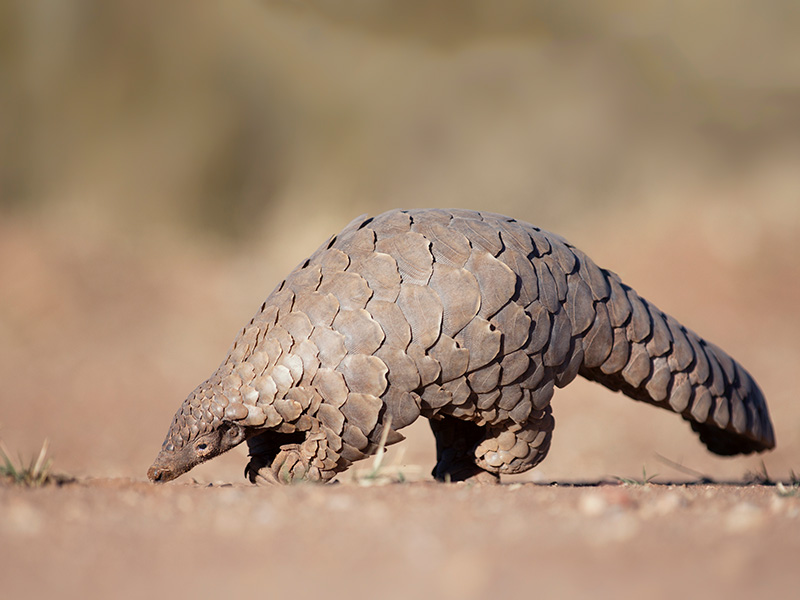Using Forensic Science to Catch Elephant Poachers

Ivory is a highly valuable material found in the tusks of hippopotamuses, walruses, and other animals, but is most commonly - and illegally - sourced from elephants. Every year, tens of thousands of elephants in Africa are slaughtered by poachers for their tusks to sell in the illegal ivory trade, contributing to the decline of the elephant population. Finding the criminals responsible for the illegal ivory trade has been a decades-long battle for law enforcement; however, forensic science tools are bringing new hope to saving this majestic species - and others.
To aid in the search for these poachers, Dr. Sam Wasser and his team of scientists at the University of Washington analyze ivory seized by law enforcement to reveal genetic and chemical signatures that can pinpoint its origin. Their forensic work has helped expose international criminal networks by uncovering connections between contraband from seemingly unrelated shipments, as well as combat the black market for pangolins, timber, and fishing.
We recently interviewed Dr. Sam Wasser and members of his lab to discuss their fascinating research and its impact on wildlife conservation.
How did you get involved in wildlife conservation?
Sam Wasser, Ph.D., Professor of Biology and Director of the Center for Environmental Forensic Science: I did my Ph.D. on wild baboons in Southeast Tanzania, which turned out to be the most poached area in Africa. While following the baboons on foot, I would run across elephant carcasses left by poachers. In 1989, the Tanzanian government had a massive anti-poaching operation that abruptly wiped out all the poaching rings in the country. One of the consequences was that leopards, which for so long had easy access to meat from the carcasses, had to look elsewhere for food. They nearly wiped out the three troops of wild baboons that we had been studying for 16 years. At that point, a lot of my study was finished.
I then realized how interrelated everything is in the environment and how significant the poaching problem was. That’s when I switched.
You developed ways to perform forensics on ivory to determine its origin. How did you build a reference database of elephant DNA sequences?
SW: We needed to extract DNA from fecal samples. In 1997, we were one of the first labs to get DNA out of feces and that just opened the whole world for us. A few years later, we discovered how to extract DNA from ivory. Now we could get a DNA reference map of elephants across Africa, which is a huge continent, by collecting dung samples, which are relatively easy to find from elephants. Comparing the DNA from seized ivory to the fecal sample map turned out to be a very precise method, and it started to quickly uncover lots of new information.
What were some of the early findings?
SW: The first finding was that the vast majority of these large shipments of ivory were from elephants poached in just two places in Africa, which really narrows down the search. We were then able to show that the poaching was occurring in a country different from where these large shipments were being exported. That meant law enforcement was looking for poachers in the wrong country when they seized ivory, if relying solely on using information in the bill of lading.

Despite international bans, hundreds of tons of poached elephant tusks are shipped from Africa each year.
What kinds of methods are you currently using in your research?
Kristen Finch, Ph.D., Postdoctoral Research Scholar: For many years, the Wasser lab has been using microsatellite markers to find or match individuals and familial groups, as well as predict the source origin of elephant ivory, which has worked well. It has put the Wasser lab in a great position as a leading lab in combatting illegal ivory trade.
But with the advancement of next generation sequencing, there is the opportunity to move that same research into SNP (single nucleotide polymorphisms) genotyping which has even more benefits. A SNP is a mutation or a variant of just one base in the DNA. Very little DNA surrounding the SNP target region is required to provide the necessary information for genotyping. These SNPs are abundant in all organisms and offer high reproductivity and accurate scoring. SNPs require a small amount of DNA, which is important as forensic samples might not contain a lot of DNA. SNP data is also a lot easier to share across labs. A big goal of ours is to make this testing accessible to collaborators in the future and make all the data compatible and shareable.
How many samples do you have in your collection?
Yves Hoareau, Research Scientist: We have a little more than 4,000 reference samples, of which about 2,400 are being used in day-to-day analysis. We have various collaborators in the field collecting more samples, so that number keeps growing. In terms of seizures, we have about 60 seizures—each over half a ton of ivory. We’re also analyzing over 20 smaller groups of samples sent by various law enforcement agencies.
How do you process ivory samples that you receive from seizures?
Ada Kaliszewska, Lab Manager: The first thing we do when we get a package is make sure all permits are correct. Next, we start a chain of custody, do an inventory of samples, and clean them to remove dirt or blood. We then take them to this amazing man in the physics department, who uses a bandsaw to cut our samples into 1 cm squares and cuts off the cementum layer which has the best DNA. We then re-wash and decontaminate the samples to get rid of anything on the surface. We use a cryogenic mill to pulverize the samples, demineralize them, and extract the DNA.
Can you tell us a little bit about the new environmental forensic science program at the University of Washington?
SW: The University of Washington is extraordinarily supportive of our program and there are so many wonderful collaborators here. I feel like I'm in the right place and that people value what we're doing.
In October 2021, we launched the Center for Environmental Forensic Science. While we haven't changed the primary mission of our lab, we have broadened the type of work that we're doing to include a variety of species and techniques. Forty faculty have joined our program from 27 different departments in the UW alone. However, CEFS also included several state and federal law enforcement agencies inside and outside the US, other scientists and NGOs.
We’ve expanded our work from elephant ivory trafficking to include pangolins, which resemble armadillos and are the most poached animal in the world right now, as well as the illegal timber trade and IUU (illegal, unreported, and unregulated) fishing. Together, these transnational environmental crimes generate well over $200 billion in profits each year and impact roughly $1 trillion to the world economy.

The pangolin is the most trafficked mammal in the world. Its scales and meat are used in traditional medicine.
You mentioned addressing illegal ivory, pangolin, timber, and fish. How are all these connected?
SW: One of the big challenges of these transnational crimes - and not just environmental crimes but also narcotics and counterfeit goods - is that products are shipped in large-volume containers. About 70% of all the world’s goods are moved in shipping containers. These criminals have capitalized on this by concealing their contraband among this legal trade. Once they get the shipment into transit, it’s so difficult to trace.
We originally developed methods to study the illegal ivory trade and how big transnational criminals move the ivory out of Africa. But then we started to see that a lot of the products are commingled. For example, 25% of all pangolin products are now shipped with ivory. Those are two species with very different natural histories. If we can figure out how the same transnational criminal organization gets both of those products in the same shipment, we can get a huge amount of useful information to disrupt the entire flow of contraband.
Timber is frequently the cover load - what they use to disguise the shipments. They declare the shipment as timber, even though it contains ivory and pangolin. But 80% or more of the timber is also illegal, which alone has huge environmental impacts like climate change and habitat destruction.
Because of these connections between different environmental issues, a lot of other people got interested in our work. So, we increased the number of species for analysis, including those related to IUU fishing.
How does a multidisciplinary approach help identify the origin of an animal?
SW: With microsatellite DNA, we can get a tusk from an elephant anywhere in Africa and determine within 180 miles of where it came from. SNPs should further increase that precision. But within that window, we are also able to overlay isotopes. For example, radiogenic isotopes like strontium in the geological layer varies across the continent. But within that 180-mile radius, it's got a very specific place where that measured level of strontium occurs, enabling the combination of DNA and isotopes to refine our original assignment to the exact place the tusk came from. That’s an example of how bringing together multiple tools to increase precision.
Another example is IUU fishing. It might be legal to catch fish in one place, but when you cross a border, it’s illegal. Fish don't see borders; they just move back and forth. Hundreds of miles are nothing to tuna. Using DNA from tuna doesn't allow us to establish where they came from very well, but if you look at the DNA from the food in their bellies, that cluster of different species may be more discriminating. If you add to that the microbiome in those fish, the combined measures potentially gives you the needed precision.
By adding next generation DNA sequencing, we now have the ability to answer these kinds of questions. We're not only sequencing the whole species - we're looking at the prey they eat, their gut microbiome, and collectively that's giving us a lot of information.
Because of these connections between different environmental issues, a lot of other people got interested in our work. So, we increased the number of species for analysis, including those related to IUU fishing.
Conclusion
The Wasser lab is at the forefront of environmental forensic science, using cutting-edge technology to combat poaching and protect endangered species. The team’s work has been pivotal in determining the origin of contraband and revealing patterns in illegal shipments, helping law enforcement identify and prosecute traffickers.